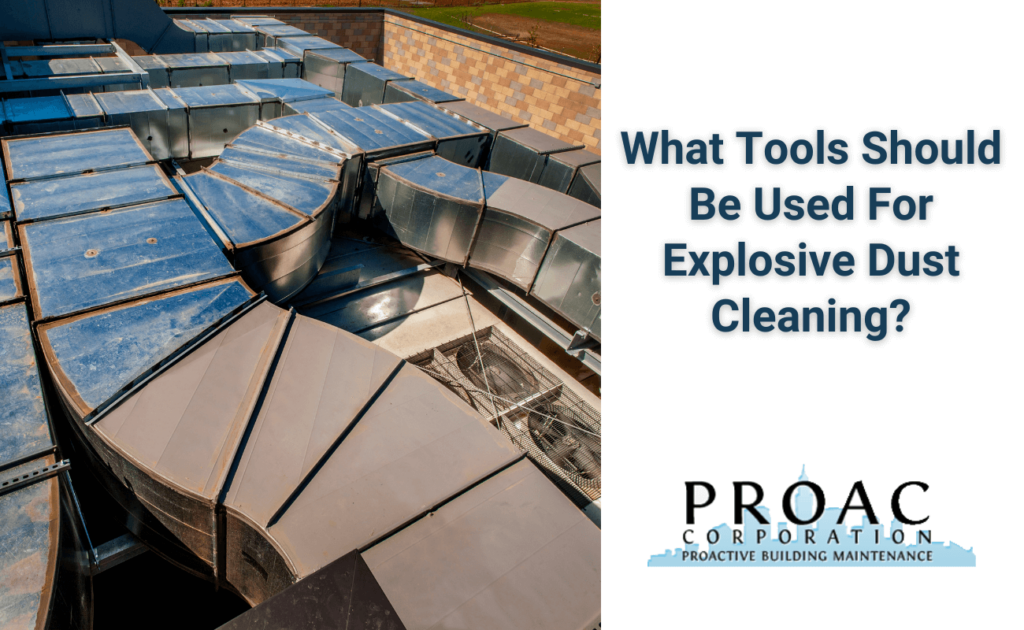Manufacturing settings are prone to combustible dust from materials and work being completed. The dust build-up can lead to dangerous working conditions, wear and tear on your equipment, and an unhealthy work environment. When it comes to cleaning explosive dust, it is important to understand the tools you should use to have it thoroughly completed and to avoid a hazardous situation. The following rules and equipment suggestions ensure that commercial businesses follow safety procedures while effectively managing the accumulation of combustible dust.
What Is Explosive Dust?
Explosive dusts are fine particles that, under certain circumstances, become flammable, explosive, or combustible when suspended in the air. If these particles catch fire in a restricted space or one with little ventilation, they could pose a serious risk of explosion.
Tools To Use For Cleaning Combustible Dust
1. Explosion-Proof Equipment:
You should always be using explosion-proof equipment while cleaning explosive dust. These tools are specifically designed to work in potentially flammable conditions without producing heat or sparks that can set the dust on fire. Examples of explosion-proof tools include:
- Explosion-Proof Vacuums
- Explosion-Proof Fans
- Explosion-Proof Lights
- Explosion-Proof Hand Tools
- Static Dissipative Brushes
- Grounded Sweepers and Collectors
2. Grounding Tools and Surfaces
The tools that are used and the surfaces you clean in your work area must be grounded to prevent static electricity from building up and causing sparks. This even includes vacuums. While they are a great tool, using a non-grounded vacuum can cause hazards. Grounding is a crucial precaution since static electricity is a typical source of ignition for flammable dust.
3. Brushes and Scraping Tools
In your industrial setting, you want to make sure to avoid using materials that could generate sparks when choosing your brushes or scraping tools. Avoid using metallic brushes, such as those composed of steel, as they pose a serious risk. Choose non-metallic substitutes, such as silicon carbide brushes, instead. Dust may be effectively removed with these tools without risking the danger of sparks or surface damage. Another choice is nylon brushes, however they are not as good as silica carbide for more difficult cleaning jobs.
4. Avoid Compressed Air
Although compressed air may appear to be an effective method of surface cleaning, it is not appropriate for cleaning explosive particles. Additional risks arise when dust is blown into the air because the particles may combine to form an explosive dust cloud. To reduce dust dispersion, you should try to vacuum or brush instead.
PROAC Will Clean The Hard-to-Reach Areas
There are certain situations where you may not be able to reach an area to clean, but PROAC gets creative to get the job done. For instance, we once used a wooden boat oar to scrape dust off a surface within ductwork. The oar’s non-metallic composition made it an ideal choice for the task. Then, the team used a silica carbide brush for a more thorough cleaning once the dust was removed. PROAC is ready to tackle any clean safely and thoroughly.
Techniques You Should Use For Brushing
Although brushing can be useful, do not use equipment not made especially for cleaning explosive dust. Sparks produced by improper tools or techniques can cause a serious risk of igniting. You should also make sure brushes are always non-metallic and made to be used in flammable conditions.
Contact PROAC For Professional Flammable Cleaning Services
Cleaning explosive dust requires careful consideration of the tools and techniques used. At PROAC, we take pride in ensuring that your work environment is clean and safe for the people and the building. By following these guidelines, you can ensure a safe and thorough cleaning process. If you are looking for professional services for manufacturing plant explosive dust removal, food manufacturing combustible dust management, cleaning for lumber mill explosive dust, combustible dust cleaning for textile mills, or explosive dust removal for any other industry, we are the place to turn. Contact PROAC today with any questions you may have about the tools you should use while cleaning explosive dust or to set up a time for us to remove flammable dust from your facility.

